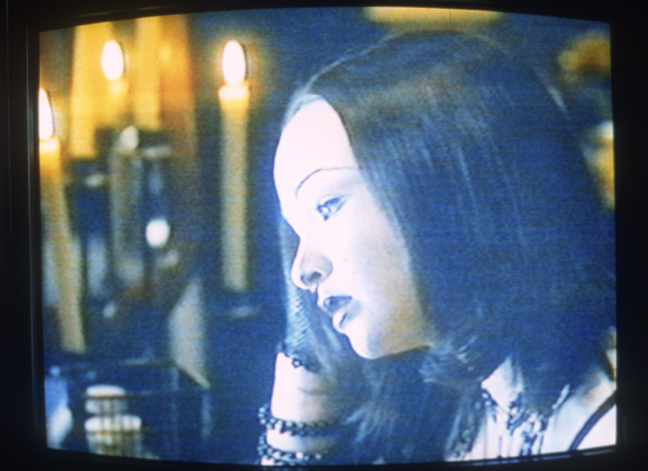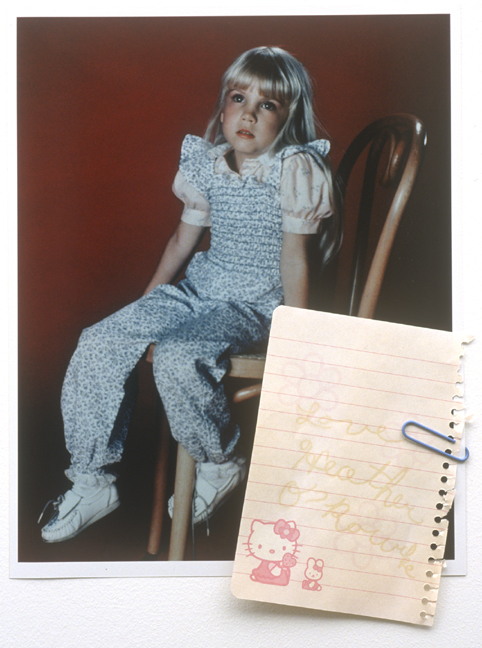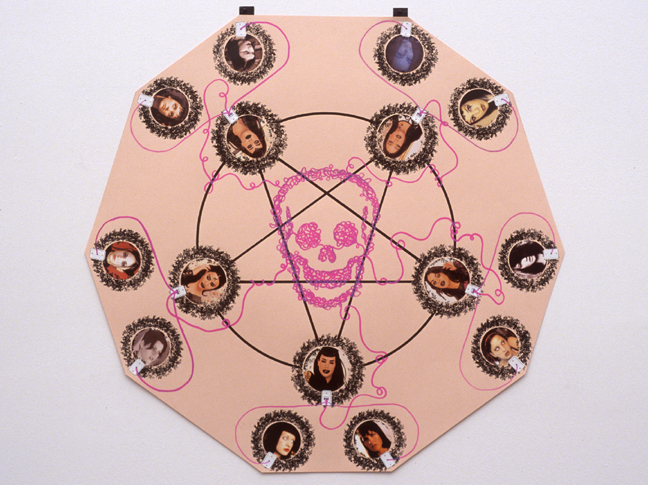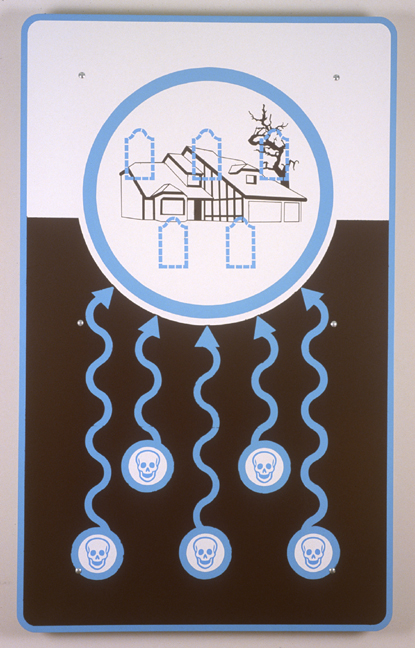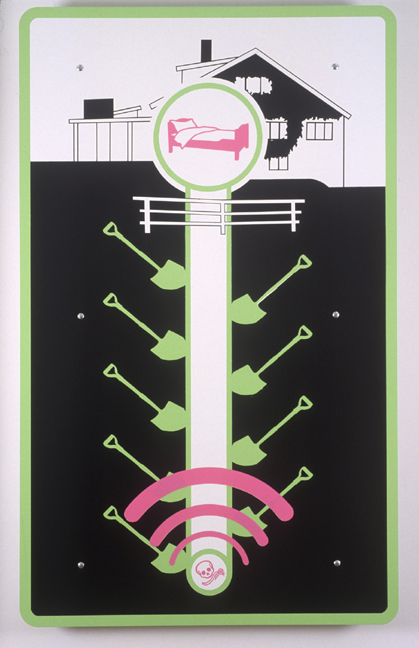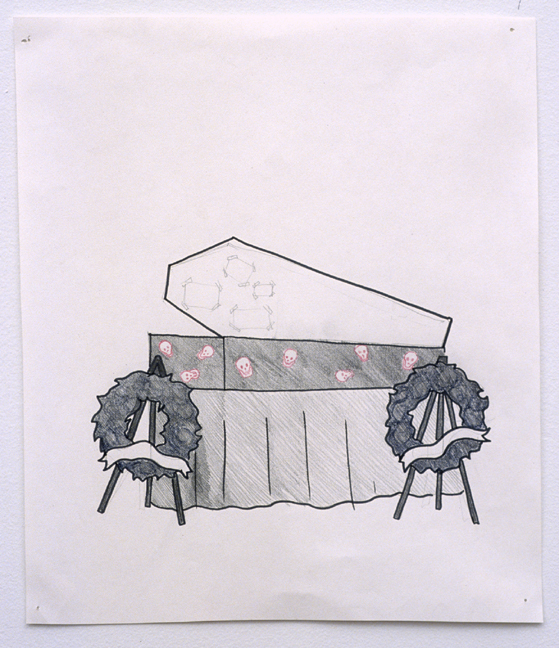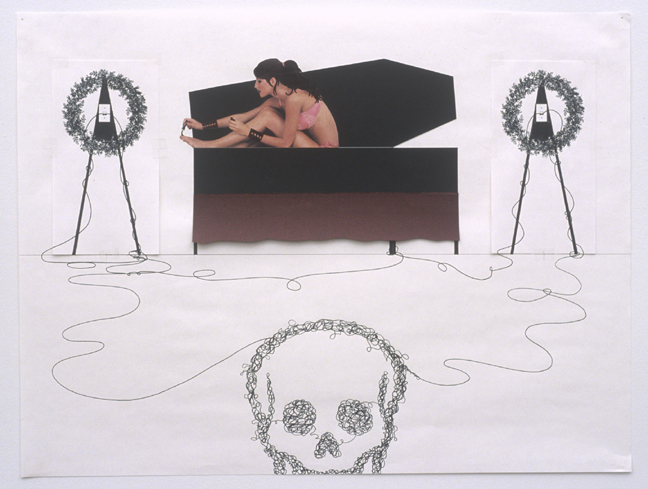Ian Cooper
Curated by Sue de Beer
April 28 – June 4, 2005
Opening Reception: Thursday, April 28, 6-8pm
Ian Cooper was born in 1978 and raised in New York City. He received a B.S. in Studio Art from New York University in 2000.
Recent group exhibitions include Let the Bullshit Run A Marathon at Nicole Klagsbrun Gallery, New York, 2004; Black Milk: Theories on Suicide at Marvelli Gallery, New York, 2004; I Am The Resurrection at Locust Projects, Miami, 2004; Video (Por)Traits at Art In General, New York, 2004; Attack! The Kult 48 Klubhouse at Deitch Projects Brooklyn, New York, 2003 and Teenage Rebel: The Bedroom Show at Agnes B. Galerie du Jour, Paris, 2003.
The exhibition at CUE Art Foundation represents the artist's first solo exhibition. Cooper will be participating in the Grizedale Arts residency program in England in August 2005. Upcoming group exhibitions include Youth of Todayat the Schirn Kunsthalle, Frankfurt, scheduled for winter 2005. Cooper lives and works in Red Hook, Brooklyn with artist Rachel Foullon, and their Chihuahua.
Video and installation artist Sue de Beer completed her MFA from Columbia University in 1998, and a BFA from Parsons School of Design in New York City in 1995.
She currently has a solo exhibition entitled Sue de Beer: Black Sun at the Whitney Museum at Altria, in New York City, curated by Shamim M. Momin. The exhibition represents the artist's first solo museum exhibition in the U.S. Other video installations currently on view include, The Dark Hearts in the Greater New York survey exhibition at P.S.1 Contemporary Art Center in Long Island City, New York, and Hans & Grete in Regarding Terror: The RAF Exhibition at Kunst-Werke Institute for Contemporary Art in Berlin, Germany, which will travel to Graz, Austria. De Beer was included in the 2004 Whitney Biennial, and has exhibited widely at venues such as The New Museum of Contemporary Art, The Brooklyn Museum, and The Whitney Museum of American Art in
New York, the Reina Sophia National Museum Art Centre in Madrid, the Neue Galerie am Landesmuseum Joanneum in Graz, and Los Angeles Contemporary Exhibitions (LACE) in Los Angeles, amongst others.
Sue de Beer is represented by Marianne Boesky Gallery in New York and Sandroni Rey Gallery in Los Angeles.
INTERVIEW BETWEEN IAN COOPER & SUE DE BEER
Sue de Beer: Testing…
Ian Cooper: Yeah, 1,2,3.
S: The music (loud howling sound in background) playing in the background is the advertisement forGinger Snaps 2, which is the sequel to Ginger Snaps 1. Which is this movie about a teenage girl that gets her period and turns into a werewolf.
I: Right.
S: And in movie number two she returns as a poltergeist and haunts her sister. Which is incredibly appropriate, because Ian happens to be working on a very wonderful new sculpture, which happens to be thematically linked to Poltergeist as well as beautiful girls, although possibly not to teenagers.
I: The forbidden.
S: Not forbidden for me.
I: No, no, no. (Sue laughs)
S: So, tell me about your interest in Poltergeist Ian. How did it start? Can you get the lights?
I: My interest in Poltergeist probably started-well, I saw the movie obviously when I was younger, and I've seen it many times. My fascination with the movie, and my fascination subsequently with the sequels, and with films in general where something like this occurs, was that there was a parallel with the film and with reality. The main character who plays this mysterious conduit for the dead ends up in reality succumbing to death herself in a mysterious way, literally right after turning 13, right after being a pre-teen.
S: So, Carol Anne's (Heather O' Rourke's) mysterious and unexpected death is a unique link for you?
I: Exactly. It's one of my main fascinations with the movie. My original link to the movie was as a result of doing those paintings that I was doing before. My focus was on the idea of this American dream house, which is a classic trope in horror movies. Where there's like- Cheers, anyway.
S: Oh yeah, cheers. (clink of glasses)
I: Where there's a house that represents American idealism that is purported to have one small problem. Or one catch, and the catch is a real moralistically atrocious one. Where it's basically that the house was built in vain atop, or with disregard of a burial ground or a gravesite or some- (loud scream in the background)
I (laughing): some marker of the dead or something. The painting series used the house from Poltergeist, which is like this California track house, South Pasadena, or actually more like San Diego, or something like that. But, that was sort of a different focus, the dead rising from the grave to reclaim their sanctity of the ground in which they were buried.
S: And communication as well, because your main sculpture is going to be a communication place, and the focus of Poltergeist is the communication from the dead to the living. Speaking through the TV.
I: Or the toy phone.
S: Can you talk about electronics being a conduit for the dead?
I: Sure, definitely.
S: It has been a consistency in your work as well.
I: Definitely, definitely. Especially in film and video; It's being able to use that idea as a reason for making video. The history of communicating with the dead, well, there's a couple of times, (laughter)…but originally the first known communicators with the dead in the "modern world," on this continent, were young girls. Teenage girls.
S: In what context?
I: Well, in the end it was said to be a hoax, á la The Crucible etc. But, the context was girls developing this sort of code or system which was actually a system of knocking on tables, as a way of knocking and getting responses with-it's sort of an early Ouija Board scenario, before legitimized Ouija Board's existed. And creating that kind of made up system, which I'm really interested in, especially with teenagers, or pre-teenagers. Where there is that heavy focus of trying to construct your world and trying to make sense of your world vis a vis this cockamamie structure that you create. So, because communicating with the dead has always been this fantastical exercise, people have always sort of brought to it these weird, intuitive systems. Like knocking, or then later people particularly used horns, like trumpet-shaped horn devices that supposedly the dead could speak through the horns to people. That's where I take off for this project, because there is this blend of early telecommunication, where Alexander Graham Bell invents the telephone, but his original purpose was to construct a way for communicating with his mother who had died. And he accidentally, or supposedly accidentally discovers this arguably more profound or practical, I should say, way of communicating with actual people.
S: And this is the first piece that I know of yours that actually points to a period backward in time. Although it feels very contemporary it also has this sort of Victorian overlay over the communication device. Can you talk about that impulse? Is that going back to Goth culture, pseudo Victorian corsets, the fetishization of a fictional past, or is it actually going back to a real historical past? (another loud scream in the background)We're also torturing people in the back room.
I: Sue's roommate shall die. (laughs) No, actually it's funny, because my interest with the switchboard, this early system for telecommunication, whether it's operators who would connect people, my interest in that sort of lends itself definitely to the more classically Gothic. My main focus, cause I'm not a real-well, my focus, and it may sound stupid, but I'm not really interested in historical accuracy, as much as selective memories, or sorry, collective memory or an accumulation of ideas that project backwards on to a time. So we know certain things about early telecommunication. I've obviously researched things to see how devices actually worked, but I am really also interested in intuitive devices like the whole idea of the cup with the string and another cup, and these kind of things that look like they should work, because it's something connected to something else, they are an illustration of something and thereby when kids are building things like that, they know it should work, because it looks like it shouldwork.
S: We were calling them "faith activated" devices when we were talking about them before.
I: I guess that I jumped ahead, because you asked me another question before. Before I talk about that, the thing that brings in the role of women, as we talked about before, again how these girls were the first discoverers or tried to patent a way to communicate with the dead. Also, women are historically the first connectors for telecommunication. Women as operators have this sort of principle connection to that activity. Which is great because also the connection with witches and witchcraft, and in general women are classically more open to the possibilities of connections with the supernatural and thereby connections with each other. That all plays into this piece which is involving five girls in this sort of sleep over party scenario and these five operators who are these kind of fictitious, supernatural women who are connecting these girls to girl characters in films. As opposed to connecting people across time and space, this sort of faith-based, Ouija-board, séance activity is connecting quote, unquote real girls, who of course are going to be actresses, to these fictional characters who are in film. To try and actually connect the characters, not even the actress, but the character!
S: Have you chosen your film staff?
I: I know a lot of them. Let's just say I haven't really committed to anything yet. I know I want Neve Campbell (as Sydney Prescott) to be one of them, to bring the post-modern notion and actually to communicate with her character even though she is self-conscious about being a character in a film that is activating a horror film. I think that will be good.
S: Jamie Lee.
I: Jamie Lee and people like that. I am basically looking for footage specifically where girls are getting calls. Because the way the operators are connecting them is through this faith device that the girls built. And through the film clip where their character is actually on the phone, answering the phone in one of those moments where they are already kind of scared and they answer the phone sort of like "hello?", you know. So, just sort of appropriating that psychological frame of mind that the character is in. She is sort of afraid-starting to get scared, and abusing that to make it seem like she is getting this weird other-worldly call. She's like "hello?" (dramatic, distressed voice) And maybe just looping that and I haven't made it yet, but I think the whole thing is going to be a failure in that the communication and connection will never-
S: So, there will be a rupture, so the first contact will be the last contact.
I: Something like that. It's never gonna quite get there.
S: Did you ever try to contact the dead when you were a kid?
I: Definitely.
S: Did you ever succeed? Or did you think that you succeeded?
I: Yeah. Definitely.
I: I started doing the Ouija Board when I was pretty young, and it's funny, cause it never really worked until adolescence. It maybe was chemistry or something, more wanting to really make it work with your friends.
S: That kind of charge and energy. I remember that.
I: Right.
S: Were you ever with a group of people who thought that they talked to the dead while you were there?
I: I was with a couple of people and we were really convinced that we had channeled a spirit. And we kept accessing more and more information and it was more and more oblique and bizarre. In retrospect, I am sure there's the possibility that it was our collective unconscious making this, and fictionalizing this bizarre account of some life. I don't remember any details specifically. But, how about you?
S: Yes. Absolutely.
I: Oh really. Let's hear it.
S: I went through an ecstatic period during childhood where I could see ghosts.
I: That you could see them?
S: Yeah.
I: Wow.
S: Yeah. When I was like nine years old. I actually remember one sleepover, I was with a couple of other girls and we had hysterically worked ourselves up to the fact that we were going to be able to talk to the ghosts in this house. The house had once been burned down and we had seen that all the family in it had perished in terrible deaths. Then separately in the night three different people had seen an aberration and I saw a dog.
I: Oh wow. You remember seeing it?
S: I remember seeing it come towards me. In retrospect the amazing thing is that age and that kind of energy. I think of that too in your piece with the five operators and the sleepover party and a faith-based device. And whether or not it's true, the belief and longing for the event makes it so physically present. You kind of construct it out of this psychic energy that you build up.
I: Right, right. So, that is much about the possibility as it is about the mental connection between whoever amasses the group of people.
S: It's such a specific energy. It is really interesting, this sleepover energy. And I always thought of it as particularly feminine, but I was only invited to female sleepovers. I was never at any all-boy sleepovers.
I: I spent most of my time with girls, and my best friends were girls. The friends that I had that were guys, there was some of that, definitely. But it wasn't nearly as intense. Or there wasn't as much of a possibility to suspend disbelief and go with that sort of feeling.
S: That makes sense because girls are more into communication and emotional transference at that stage. That's really interesting.
I: Let's talk a little more about past experiences with communicating with the dead, because I think it's a really interesting topic obviously.
(Loud scream in background) S: Yeah (laughing)
I: Cue.
S: Who did you communicate with?
I: It's interesting, because what I recall, most specifically, communicating with male spirits. It was always like-actually this ties into our project a little bit too, were these questions-
S: Fantasy, fantasizing death, fantasizing being dead.
I: Right. The Séance Ephemera Kit Project that we have been working on when we-
S: Which is this extraordinary project that everyone should mail away for a kit.
I: Yeah!
S: You get a coffin in the mail and you get to use the coffin to describe your own death and make lemon juice letters, and it's incredibly great. To get the coffin you mail to The Empty Grave…
I: The Empty Grave, at 14 Verona Street, apartment 2B, Brooklyn, NY 11231.
S: You get a coffin in the mail.
I: You get a coffin in the mail.
S: But to get the coffin you have to describe your own death eloquently to us.
I: Through a series of activities. Because what we were trying to get at is those classic things when you are trying to communicate with the dead. Those standard things that you want to know. You want to know something about the person. You wanna know how they died. You wanna know and be able to obtain some sort of memorabilia and some sort of tangible thing from the person. This is all linked to the internet too. It is also connected to telecommunication and its most advanced form now, as a spirit communication device and it's more ethereal because you don't know if they really exist and if they really are who they are. Likening the internet to this sort of spirit world, and we're luring people out of the spirit world to communicate with us in a more traditional mail art kind of way.
S: Yeah.
I: Just jumping back from before, my fascination with Heather O'Rourke (Carol Anne from Poltergeist), she is really dead. She is a person who is really dead. In her films, she crosses over. It has been really creepy for me to use her. As an aside, do you have a really good ghost story?
S: Good ghost story?
I: Or a good ghost story that happened to someone else?
S: Probably, but they probably have their own personal quality…I remember that feeling. When you're listening to ghost stories. That decision-making process-How do you escape death by specific kinds of games. That also talks about specific invented symbol systems, which is what you were talking about before. And also the child-like rules that either create protection, or create supernatural-ness.
I: Definitely, or wards away things. Stephen King loves that kind of shit.
S: Keep the spirits at bay.
I: Absolutely. Going back to the female connection or the mass hysteria in The Crucible, when they are all seeing spirits. There's this incident that happened to Rachel when she was younger where she and her girlfriends in junior high school were having a sleepover. I forget exactly how it starts, but basically one of them was convinced that they saw this little creature, like this little man, which I thought was this great allegorical thing, because they were all coming of age. There was this little man-like creature that was in the room. And it got them really scared, and the person named it and named it Bobbit. And I thought that was such a great, creepy name. And this would go on for days and weeks would go by and girls would be like, "oh my god, I saw Bobbit in the girl's room." "I saw him when I was in there." And they would get really hysterical. And it got to the point where moms would call other moms and be like "This is ridiculous. This has to stop. This is crazy." I love that whole idea.
S: I thought that Peter Jackson captured that really well in his film Heavenly Creatures.
I: Very well.
S: It's one of the few movies that I have seen that addresses this phenomenon. That teen girl, visionary hysteria.
I: That's an amazing movie obviously.
S: Ends in a lovely murder.
I: And again based on completely unfounded, cockamamie decision-making.
S: Do you think about the ecstatic moment at all in relation to your work?
I: I think the really interesting difference in our work would be the interest in the physical. I always see you work especially in relation to the body and blood and body transformation and mutilation. Especially, in the earlier photos-having been one!
S: (laughs)
I: Having had a close personal encounter. Even when we first met, and we were both working on this scene from Nightmare on Elm Street in very different ways. I always shy away from actual blood, actual murder, and actual violence. And my interest is more in the cutesy, strike that, more of the possibility.
S: They're simple systems. Like the alphabet or language, they surround an experience. What I was asking, if the experience related, or there's a transformative moment. The object that becomes animated by the spirit; these tract houses that get filled with the supernatural, or even the coffin getting filled with the supernatural, or even the coffin getting filled with the living human being. Where the inanimate becomes animate.
I: Yeah, I love that.
S: An annihilation of deadness.
I: Re-animation.
S: But, it doesn't create un-deadness. It's really tender and it's seen through the eyes of a living being. It's like nostalgia, but it's nostalgia in a sweet way. A sweetness of memory.
I: Yeah. Totally. A darkness and sweetness.
S: Completely. Or sweetness coming out of darkness.
S: It's like in the movie Goonies when they actually find the pirate ship.
I: Definitely.
S: That moment when the unbelievable becomes real.
I: That's great.
S: That's the basis of the optimism in your work, because your fantasy world is based around images of death and ghosts. There is this kind of beauty and sweetness and optimism. Somehow it ties to that as well.
I: That's a great movie to reference for that. That and elements of E.T. and The Explorers and there is this collective-Steven Spielberg is obviously really interested in that. Where a group of kids can make something happen, just based on belief. Which is what this faith-based device is all about in my work.
S: And there's a dark thread to all those films as well.
I: Totally.
S: E.T. looks like this walking fetus that is kind of slimy and he's living in the closet.
I: And that moment where he gets sick by the river in the daytime is the most awful thing ever.
S: Completely gross. Which is also interesting too. And in Ghostbusters where there is the satanic ritual, or the pseudo-satanic ritual at the end.
I: Obviously Ghostbusters is a complete foundation for everything for me.
S: I wonder if our? culture was more satanic than others. Nuclear annihilation and finding pleasure in the macabre.
(Loud scream in background)
S: Cue scream. I guess that's also what's interesting in Scream 2. It is us looking on the idea of the fear that we experience through voyeurism and through fiction and finding it to be real. It's also got the faith-based device effect, because you will things to be through belief.
I: And through dedication, that the making of a film into a reality can be possible. This self-reflexive relationship, especially for our generation, and generations younger than us. That it is all mapped out for them and that you fit yourself into this groove. What you should be like and fitting yourself into a narrative framework like a film. Imagining yourself as "x" character from The Breakfast Club. Identification is really interesting.
S: The interesting thing about those films is that they were all about creating unification from difference. Where everyone comes in different, and discovers that they all seem to have the same inner sole. Where as now, difference remains difference and archetypes get knocked off at different points.
I: Totally!
S: Like Blair Witch or Blair Witch 2. Or that other movie where people are fighting death-
I: Final Destination.
S: Final Destination and Final Destination 2.
I: Totally.
S: Rent it! Rent it!
(Loud scream in the background)
The above is an excerpt from the interview originally published in North Drive Press, Summer Kit, 2004, generously lent for republishing in Ian Cooper's exhibition catalogue at CUE by Matt Keegan.
View CATALOGUE

